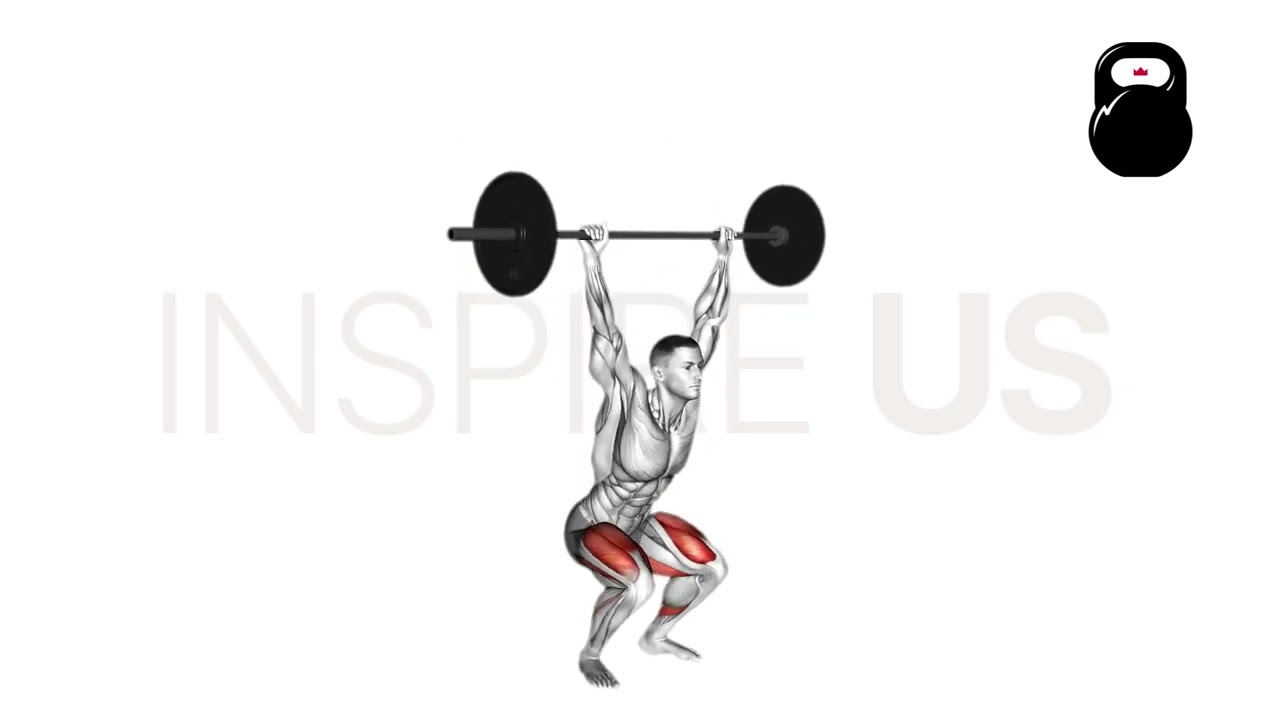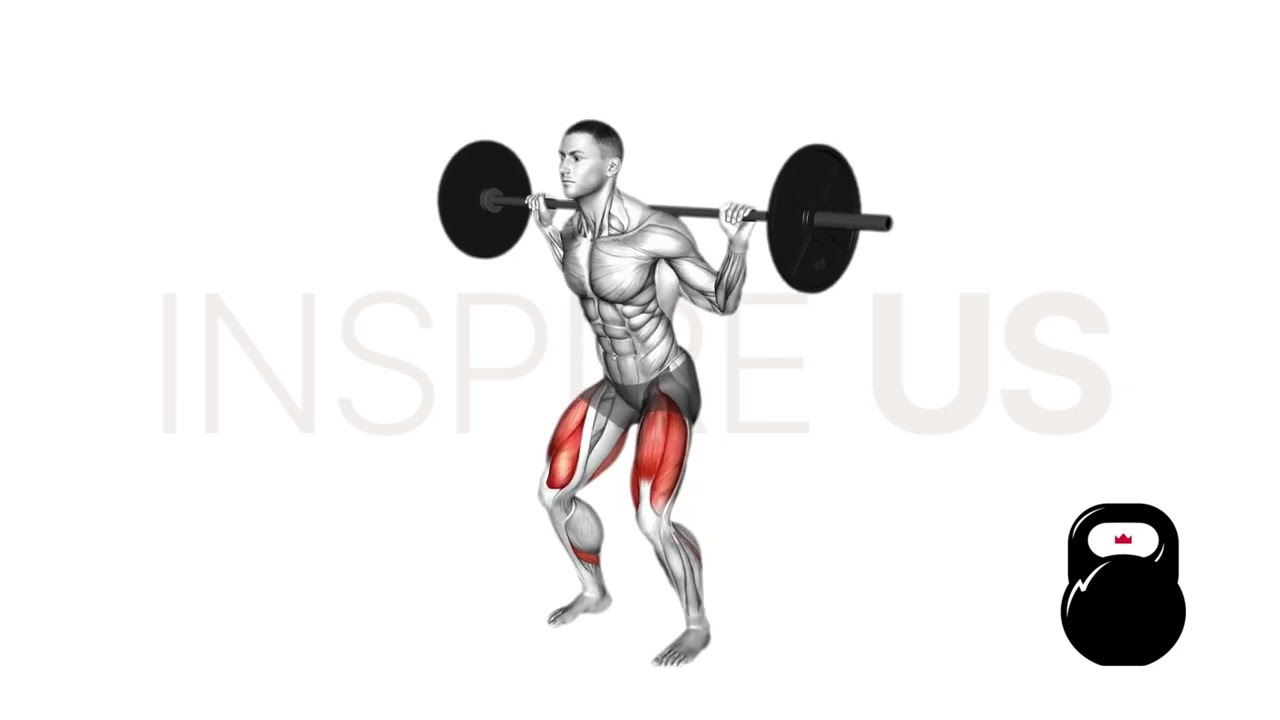Overhead Squat vs Back Squat: Differences Explained
The overhead squat involves a lesser loading capacity and significantly greater technical skill, balance and mobility than the back squat.
In comparison, the back squat allows for far greater loading and strength development but will not build mobility, balance or skill to the same extent as their overhead counterpart.
What is the Overhead Squat?
The overhead squat is a compound free weight exercise involving static overhead extension and significant use of knee and hip flexion. It is primarily performed by Olympic weightlifters and similar types of athletes for improving balance, sports-specific skills and mobility throughout the body.
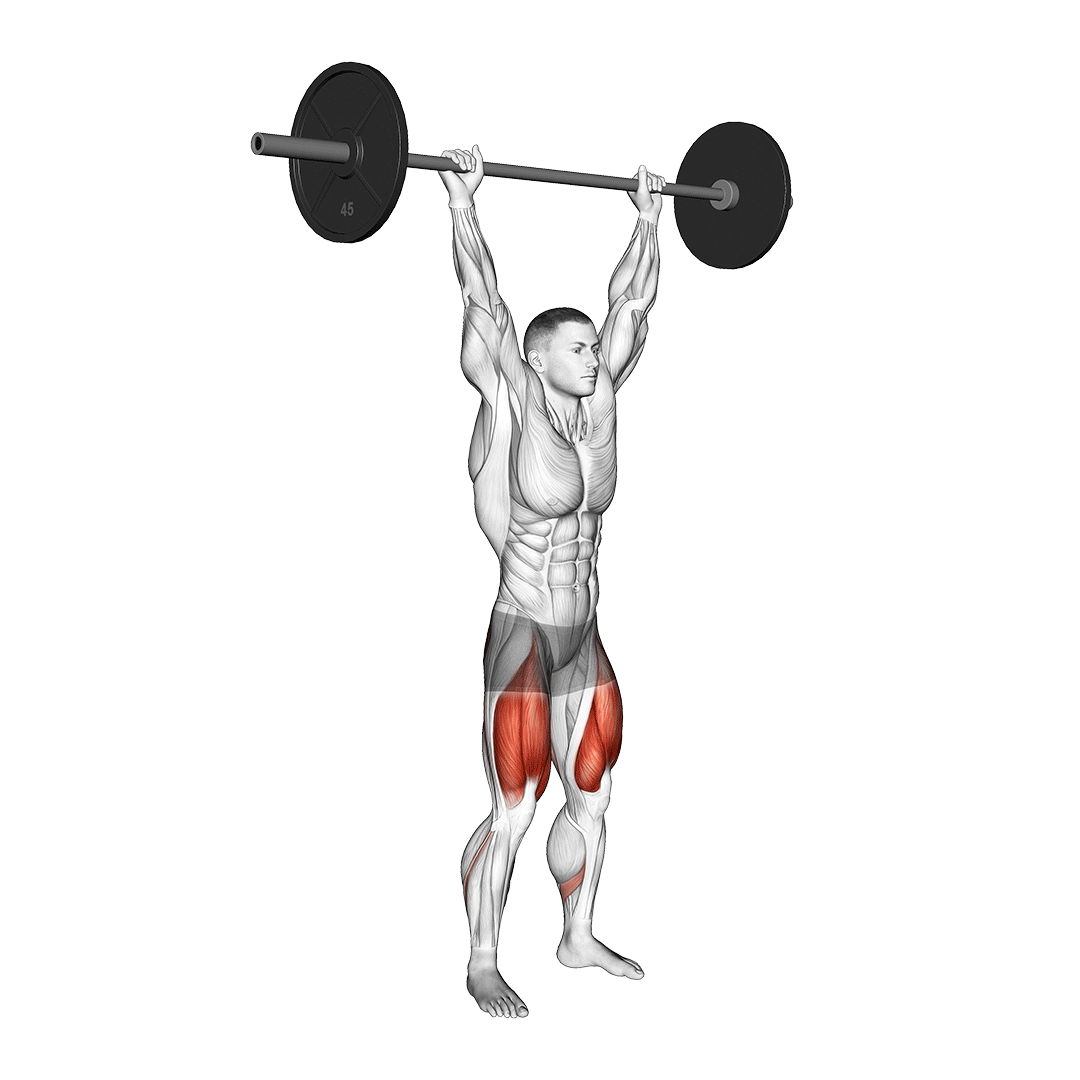
Contrary to what many believe, the overhead squat does not actually involve pressing the bar overhead at any point during the movement. Instead, the squat begins and ends with the bar already held aloft, never once moving until the set is complete.
Overhead squats are considered to be quite difficult from not only a strength standpoint but also in terms of hip and shoulder mobility - as well as in the lifter’s sense of coordination, bodily awareness and general control over the weight itself.
How-to:
To perform a repetition of the overhead squat, the lifter will begin by first pressing a barbell loaded with a moderate amount of weight straight over their head, hands set slightly wider than shoulder-width apart.
Ensure that the head does not jut forwards and that the shoulders are in a neutral rotation, preventing the bar from falling backwards.
With the bar held in this position, the lifter sets their feet approximately shoulder-width apart and pushes their hips back as they bend at the knees. The chest must remain upright and pushed out with the spine neutral and the core braced.
Once reaching parallel depth or lower, the lifter then drives through their heels and rises back to a standing position - barbell still extended overhead throughout the entire repetition.
When back in a standing position, the repetition is considered to be complete.
What is the Back Squat?
The back squat is a classic free weight compound movement involving use of hip and knee flexion while a loaded barbell is placed atop the back of the shoulders and trapezius.
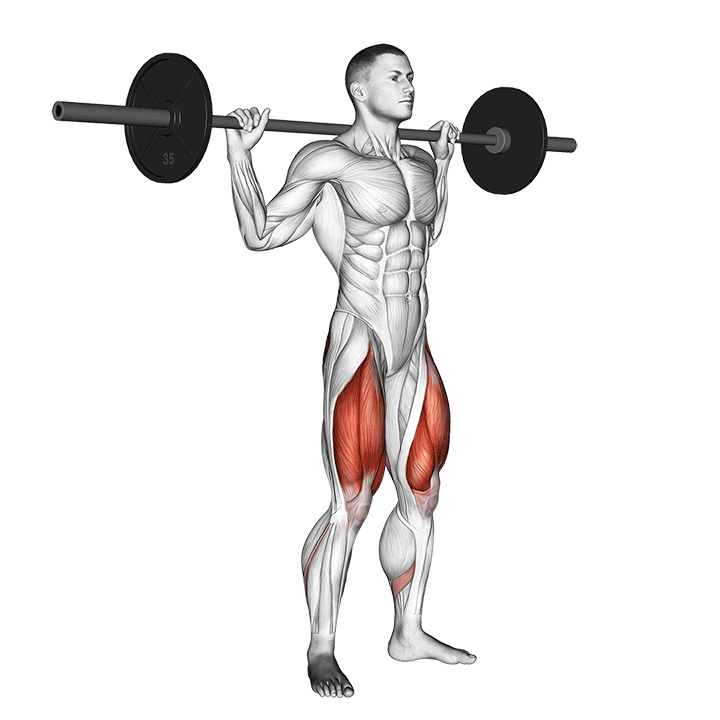
Back squats are an extremely common strength training movement, and are performed for purposes ranging from simple muscular hypertrophy to practicing competition lifts for powerlifters and similar types of athletes.
Although back squats are considered to be novice-friendly so long as proper form is learned first, they are utilized even by elite lifters due to the sheer effectiveness at building muscular size and strength that they offer.
How-to:
To perform a repetition of the back squat, the lifter will unrack a loaded barbell atop their trapezius and the back of their shoulders. The feet should be set somewhere around shoulder-width apart, toes pointing forwards or slightly outwards with the core braced and the spine neutral.
In this stance, the lifter shifts their hips backwards as they bend at the knees - lowering themselves until the crease of the hip is at least parallel with the top of the knee, if not lower.
Now at proper depth, the lifter squeezes their glutes and drives through their heels. This should extend the knees and push the hips forwards as they rise back into a standing position.
Once returned to their original standing position, the repetition is considered to be complete.
Overhead Squat and Back Squat Muscles Worked
Although both the overhead and back squat feature quite similar movement patterns, the position of the barbell can alter recruitment of muscles other than the primary movers.
Keep in mind that this is only comparative muscular recruitment - in actuality, the back squat is largely more effective at developing the lower body as it allows for greater loading and volume.
Quadriceps, Glutes, and Hamstrings
The overhead and back squat feature practically identical stances and movement patterns (in regards to the lower body).
As such, in terms of which exercise recruits the quadriceps more, the overhead variant is slightly better during the concentric phase of the movement as a result of the slightly more vertical torso orientation and greater balance demands.
Of course, this difference is miniscule at best in comparison to the back squat, and is not present in the glutes or hamstrings - of which are targeted ever so slightly more by the back squat.
However, remember that gross muscular recruitment does not necessarily equate to better development over the long term.
Other factors inherent to the back squat (ease of progression, less non-muscular demand and greater loading) make it better for developing the quads, glutes and hamstrings despite slightly less recruitment at the same relative load.
Upper Body Musculature Worked
When comparing the overhead and back squat, we are specifically referring to the deltoids and triceps, as the back squat does not actually load any muscles in the upper body apart from the usual trunk stabilizers.
Because a loaded barbell is held with the arms in a fully extended state, the triceps and deltoids are both worked in an isometric capacity during an overhead squat repetition. This is otherwise not present with back squats.
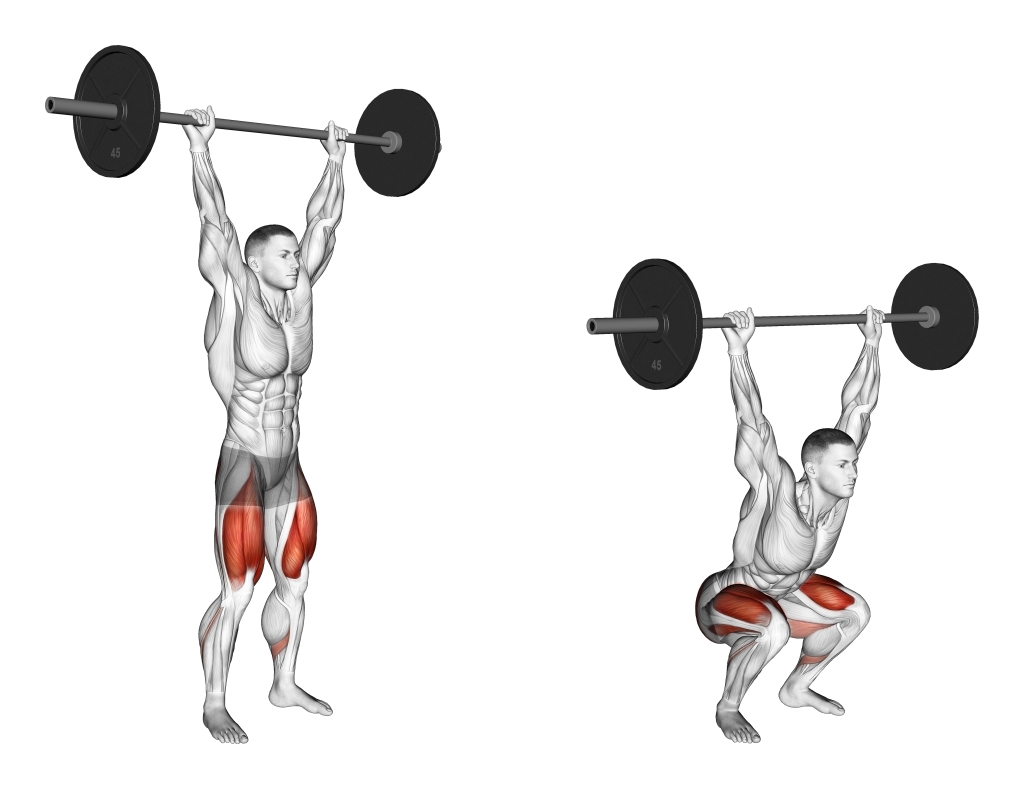
Abdominal Muscles, Erector Spinae, and Other Trunk Muscles
Both the back and overhead squat recruit muscles like the rectus abdominis, obliques, spinal erectors and those of the lower back to stabilize the entire body and the load itself.
However, as mentioned previously, the overhead squat is considerably more demanding as far as balance and stability goes. While the back squat indeed recruits these muscles to an intense degree, the overhead squat is incomparably moreso.
For developing the body’s muscular stability and the lifter’s sense of balance itself, the overhead squat is better.
Mechanics, Stance, Loading Capacity and Form
The muscular activation differences seen between the overhead squat and back squat are a result of their unique stances, what sort of mechanics are used and the overall form of either exercise.
In turn, these distinctions affect how much weight can be lifted with either exercise, and the sort of applications or benefits offered.
Main Mechanical Differences
As mentioned previously, the general lower body mechanics of the overhead and back squat are practically identical. Both exercises involve significant hip and knee flexion in the eccentric, with the opposite mechanics in the ensuing concentric phase.
However, due to the more vertical torso angle, lifters with sufficient mobility may find that the overhead squat is somewhat easier with a greater degree of hip flexion. Furthermore, a slightly greater level of leg abduction (at depth) may be used in order to better maintain stability with the bar overhead.
Stance Differences
In terms of general stance, the overhead squat allows for a somewhat wider foot position to be adopted if mobility and technique allows. This aids with stability and will help reduce strain on the knees as there is less immediate vertical load being translated through them.
In comparison, the general advice for back squats is a shoulder-width stance that can be modified according to individual capacity and preference.
Furthermore, the torso need not be as vertical as would be the case with overhead squats, reducing trunk stabilizer demand and creating an easier time achieving proper hip flexion.
Loading Capacity
Because the barbell is resting atop the back rather than lifted overhead, the back squat is clearly the better choice for lifting more weight. Although the numbers vary, the majority of lifters will only be able to overhead squat 60% of their back squat if accounting for 1RM ratio.
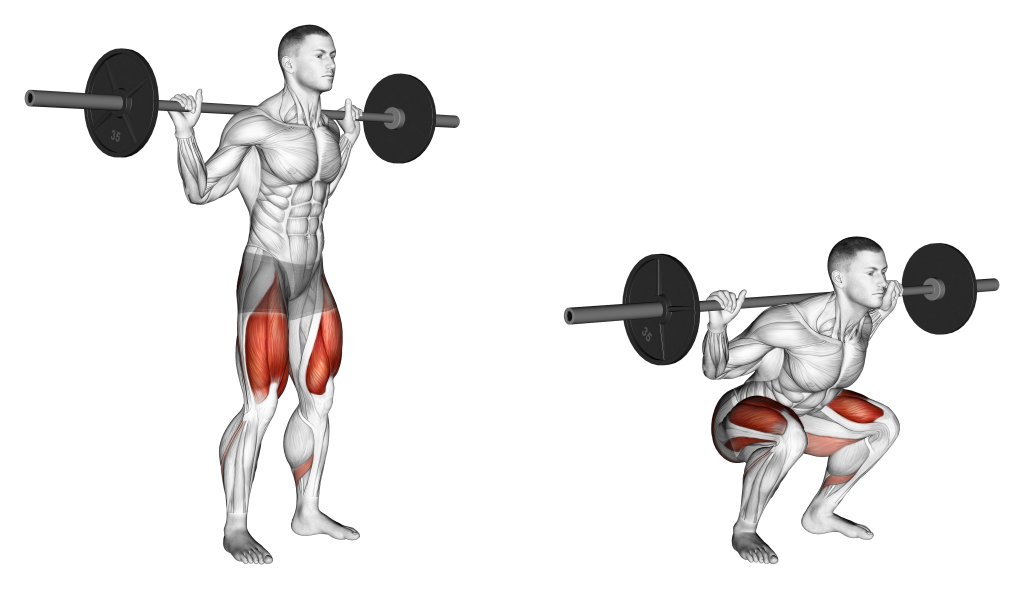
While more weight does not necessarily translate to better development, it is nonetheless an important aspect of progression in both an overload and periodical methodology.
Furthermore, greater loading capacity brings other benefits aside from those of the muscular - such as improved bone density, conditioning to carrying heavy loads and an easier time making incremental increases.
Applications, Benefits and Role in Resistance Training
Tallying up the various mechanical and physiological differences seen with either squat variation, we can get a picture of how these exercises fit into different training disciplines.
Applicability of the Overhead and Back Squat to Various Sports and Disciplines
Across the board, for building pure lower body strength, muscle mass, explosiveness and power, the back squat is the better choice.
With a greater loading capacity, lower technical requirement, lesser injury risk and more isolated recruitment of the lower body’s muscles, this comes as no surprise. Powerlifters, individuals with careers that demand pure physical strength or bodybuilders will all benefit better from the back squat over its overhead cousin.
On the other hand, for stability, practicing squatting technique during overhead extension, balance, full-body isometric contraction and mobility, the overhead squat is better.
Olympic lifters, CrossFit athletes and lifters who require these benefits from their training will find that picking the overhead squat is more relevant to their training goals than the back squat.
Program Role and Use Cases
Speaking strictly in the contexts of traditional non-specific resistance training, the back squat is meant to take precedence over the overhead squat due to its greater intensity and higher loading capacity. Performing back squats after overhead squats can result in premature fatigue, injury and poor performance.
Likewise, the overhead squat is more effective in the role of a secondary compound movement as it requires less weight to challenge the lifter, and is not necessarily meant to build significant strength or muscle mass.
Of course, in sports-specific training programs or non-traditional training systems like CrossFit, this is not entirely the case. The overhead squat may be included into a cyclic training drill, or prioritized over the back squat due to its relevance to the athlete’s goals.
Other Considerations
Before deciding on which exercise to perform, consider the following aspects as well.
Accessibility and Complexity
Across the board, the overhead squat is both more complex and less accessible than the back squat.
In fact, one may go so far as to say that novice lifters should first master low-weight back squats prior to even attempting overhead squats.
This is simply a result of adding an additional dimension to the conventional squat pattern (the overhead extension), and that the latter movement requires greater mobility in certain joints.
So - for novices or lifters just recently returned to training, it is best to pick the back squat over the overhead squat until better technique and mobility have already been established.
Injury Risk and Joint Impact
Comparing the injury risks of both overhead and back squats is a bit nebulous, as the back squat is considerably heavier and as such more likely to result in compression or chronic injuries of the back - whereas the overhead squat is lighter but is more demanding in terms of technical skill and mobility.
While the back squat is more likely to result in injuries to the spine, knees or lower back, the overhead squat is more likely to result in acute injuries of the shoulder joint, neck or those related to falling over due to a loss of balance.
If you have a history of injury in the spine, back, shoulders, hips or knees, speak to a medical professional prior to attempting either squat variation.
Performing the Overhead Squat and the Back Squat Together
If needed, it is entirely possible to perform both exercises within the same workout. So long as total training volume and intensity is mitigated, this is unlikely to result in injury or overtraining.
Unless otherwise needed by your training goals, prioritize the back squat by placing it first in the workout’s order of exercises, with the overhead squat being ordered later in the workout. Furthermore, aim to lift only 50-60% of your back squat working weight when performing the overhead squat.
Finally, remember to temper total training volume by eliminating a few sets of lower body isolation exercises that may still be present in your programming. Multiple sets of both overhead and back squats will quickly fatigue the muscles, joints and central nervous system.
Which Squat is "Better", the Overhead or Back Squat?
As is the case in many exercise comparisons, the answer is that it depends.
The overhead squat certainly has its own merits against the back squat, and is arguably superior in certain contexts - but for the average non-competitive lifter, the back squat is the way to go.
Even then, many athletes who require the overhead squat in their training will still rely on the back squat for developing a baseline of strength and power in the legs.
Our advice is to prioritize the back squat and rely on the overhead squat solely for developing athletic skill and balance in the body.
References
1. Aspe, Rodrigo R, and Paul A Swinton. “Electromyographic and kinetic comparison of the back squat and overhead squat.” Journal of strength and conditioning research vol. 28,10 (2014): 2827-36. doi:10.1519/JSC.0000000000000462
2. Park, Ju-Hyung et al. “Influence of Loads and Loading Position on the Muscle Activity of the Trunk and Lower Extremity during Squat Exercise.” International journal of environmental research and public health vol. 19,20 13480. 18 Oct. 2022, doi:10.3390/ijerph192013480
3. Auferoth, Steven J. C.S.C.S.; Joseph, Jon. EXERCISE TECHNIQUES: The overhead squat. National Strength and Conditioning Association Journal 10(5):p 24-27, October 1988.

